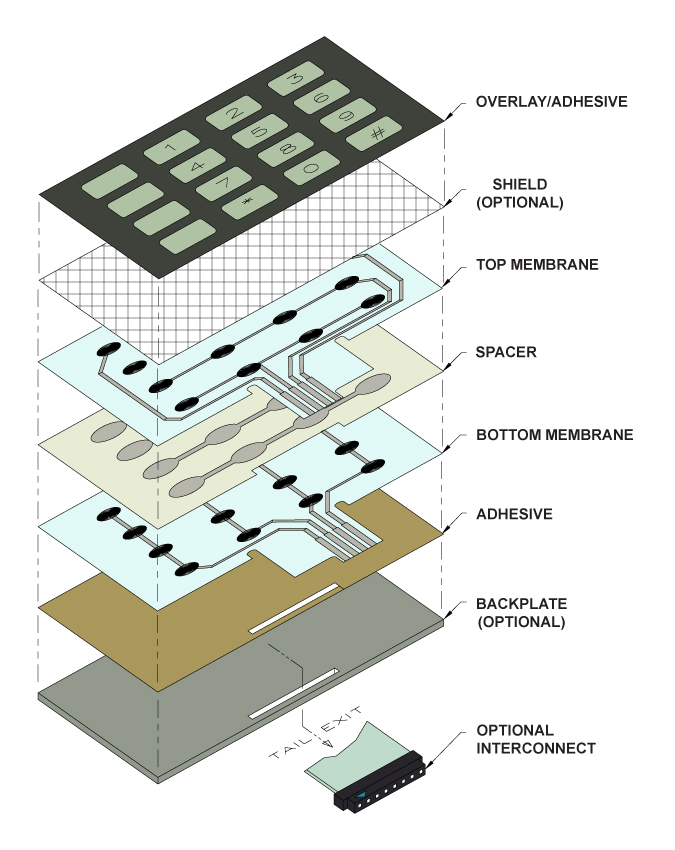Understanding the Performance of Membrane Layer Changes for Interface Instruments
The capability of membrane layer changes represents a substantial innovation in individual interface layout, combining effectiveness with visual flexibility. As markets significantly focus on individual experience, comprehending the subtleties of membrane layer switch technology becomes necessary.
What Are Membrane Layer Switches?
Membrane switches are cutting-edge user interface devices that promote user communication with electronic tools. These functional parts contain numerous layers, including a graphic overlay, spacer, and a published circuit layer. The style enables a seamless integration right into various electronic tools, boosting both the aesthetic and practical facets of customer interfaces.
Membrane layer buttons are frequently employed in a variety of applications, from family appliances to industrial machinery and clinical tools. Their building normally includes a slim account, making them an optimal option for compact styles. The responsive feedback offered by these buttons can be engineered to meet particular customer choices, making sure reliable interaction in between the user and the gadget.
Longevity is one more considerable advantage of membrane layer buttons, as they are immune to dust, wetness, and chemicals, which improves their life-span popular environments. Furthermore, these buttons can be tailored in regards to form, size, and graphic layout, permitting branding and user-specific features. Generally, membrane changes stand for a useful service for boosting individual experience in digital tools, combining functionality with aesthetic allure in an effective fashion.
Just How Membrane Layer Switches Over Job
Operating on an uncomplicated concept, membrane layer switches utilize a split building and construction to register user input successfully. Each switch is composed of several layers, consisting of a published circuit layer, a spacer layer, and a leading graphic layer, which are made to collaborate flawlessly. When an individual presses the leading layer, it compresses the spacer layer, bringing the conductive elements of the circuit layer into call with each various other.
This call creates a shut circuit, indicating the gadget to carry out a certain function. The style permits for various arrangements, consisting of responsive feedback, which can boost the customer experience by offering a physical sensation upon activation. The materials made use of in membrane layer switches typically include adaptable substratums, such as polyester or polycarbonate, which make certain sturdiness and resilience against damage.

Trick Benefits of Membrane Buttons

An additional significant advantage is their density. Membrane switches are slim and lightweight, which allows producers to conserve space in their gadgets without compromising performance. This attribute is specifically beneficial in applications where weight and quantity are important factors to consider.
In addition, membrane buttons are resistant to dust, dampness, and chemicals, enhancing their durability. This strength prolongs their life expectancy and decreases the requirement for frequent substitutes, leading to price financial savings gradually.
Moreover, the responsive feedback provided by membrane layer switches can be enhanced to improve user communication. They can consist of attributes such as raised switches or distinct clicks, boosting usability and individual experience.
Applications Across Industries
Interface gadgets making use of membrane switches prevail in a broad array of markets, showcasing their versatility and performance. Membrane Switch. In the medical market, published here membrane layer switches are integral to gadgets such as analysis devices and client tracking systems, where their resilience and ease of cleansing are important for keeping health criteria. Similarly, in the automotive market, these switches are employed in dashboard controls and infomercial systems, giving a sleek and modern interface for individuals.
Additionally, the consumer electronic devices field advantages from membrane layer buttons in home appliances and portable tools, where compact style and user-friendly interfaces improve individual experience. Industrial applications likewise take advantage of membrane switches over for control panels in machinery and automation systems, emphasizing their effectiveness and resistance to extreme atmospheres.
In the aerospace and protection sectors, membrane layer buttons are used in cabin controls and continue reading this devices, where reliability and efficiency under extreme conditions are vital. Additionally, the video gaming industry increasingly includes membrane layer buttons in controllers and arcade makers, adding to an engaging individual experience. On the whole, the flexibility of membrane switches allows their widespread usage throughout many fields, underscoring their significance in contemporary individual interface style.
Future Patterns in Membrane Switch Technology

In addition, using advanced materials, such as polycarbonate and polyester movies, is anticipated to climb, providing boosted durability and resistance to environmental stress factors. These products add to the total longevity of membrane layer switches, making them suitable for harsher industrial applications.
Furthermore, the consolidation of smart technology, consisting of IoT connection, will make it possible for membrane layer switches to interact with various other gadgets and systems, facilitating a more interactive user experience. This fad straightens with the growing demand for clever tools across numerous fields, from health care to customer electronics.
Finally, customization choices are anticipated to broaden, permitting producers to produce bespoke services tailored to particular customer needs and choices. These growths will certainly place membrane layer switches as essential components in the evolution of user interface technology.
Final Thought
In verdict, membrane switches stand for a critical improvement in individual interface modern technology, providing a reputable and functional service for diverse electronic applications. Their split building and construction helps with compact style, while attributes such as responsive comments boost individual communication. The longevity against ecological aspects better strengthens their utility across numerous sectors. As improvements in material scientific research and touch picking up technologies proceed, the functionality and applicability of membrane layer switches are anticipated to broaden, strengthening their importance in modern electronic devices.